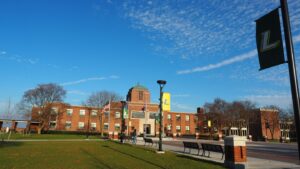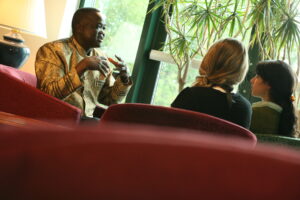Academic Programs at Le Moyne College
On The Heights, academics are more than majors, they’re mission-driven journeys, rich in the liberal arts. Whether you’re exploring your interests and deciding your future goals or pursuing a clear career path, you’ll find strong programs, supportive mentors, and opportunities to learn by doing. All led by our award-winning faculty who share their passions and will teach you how to use your unique talents to meet the world’s most urgent needs
A Comprehensive Liberal Arts Education for a Lifetime of Professional Success
No matter your major at Le Moyne, you'll enter the workforce with exceptional critical thinking and communications skills that will set you apart from your peers.
Undergraduate Programs and Majors
From small class size to individual attention from faculty, your undergraduate academic experience will provide opportunities to explore, encounter and question the world you know and the world in which you'll make your mark.
Graduate Programs
From nursing to physician assistant studies to MBA programs to education, our graduate experience offers nationally recognized programs to advance your studies. Find your next professional move.
Part-Time Programs
Le Moyne offers part-time registration, advising, Veteran services and support, as well as extra curricular opportunities for part-time students. Explore ways to make the pursuit of a Le Moyne education fit into your schedule.
Meet Our Faculty
140 Full-time faculty members
85% Of Le Moyne faculty members have Ph.D. degrees
12:1 Student-to-faculty ratio
140 Full-time faculty members
85% Of Le Moyne faculty members have Ph.D. degrees
12:1 Student-to-faculty ratio

During my time at Le Moyne I refined my capacity to communicate, to think critically and to approach scientific questions with an open mind. This set me on my career path raising awareness of our ecosystem.”

Additional Academic Programs at Le Moyne
What Can I Study at Le Moyne?
Le Moyne offers over 100 undergraduate majors, minors, and special programs across the arts, sciences, business and health professions.
Le Moyne offers over 100 undergraduate majors, minors and special programs of study, including Bachelor of Arts and Bachelor of Science degrees.
Le Moyne offers over 100 undergraduate majors, minors and special programs of study, including Bachelor of Arts and Bachelor of Science degrees.
- Psychology
- Nursing & Health
- Biological Sciences
- Finance & Business
- Political Science
See all our undergraduate programs of study.
- Psychology
- Nursing & Health
- Biological Sciences
- Finance & Business
- Political Science
See all our undergraduate programs of study.
Every Le Moyne student experiences our core curriculum, which simultaneously supports your major and also exposes you to classes outside your major. This approach to learning will give you the tools to understand complex problems and create meaningful change in the world.
Every Le Moyne student experiences our core curriculum, which simultaneously supports your major and also exposes you to classes outside your major. This approach to learning will give you the tools to understand complex problems and create meaningful change in the world.
Yes! Our students often combine majors or add minors (sometimes multiple) to tailor their education to career goals.
Yes! Our students often combine majors or add minors (sometimes multiple) to tailor their education to career goals.
You’ll gain a broad intellectual foundation plus practical skills in your field of study, preparing you for career success and a life of purpose.
You’ll gain a broad intellectual foundation plus practical skills in your field of study, preparing you for career success and a life of purpose.


Meet the Provost and Vice President for Academic Affairs
James P. Hannan, Ph.D.
"As Provost and Vice President for Academic Affairs, it is my privilege and pleasure to lead the divisions of Academic Affairs and Student Development. Bringing academics and student life under the purview of the Provost creates an inclusive, collaborative, and vibrant institutional culture focused on student success in all facets of the undergraduate and graduate experience."
Explore More






